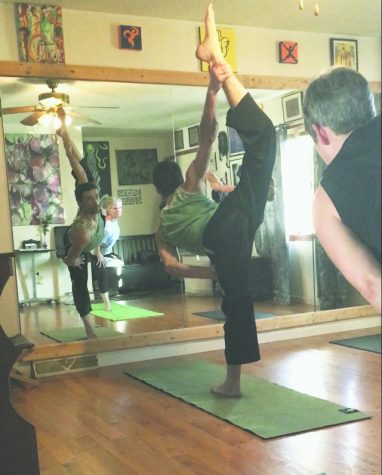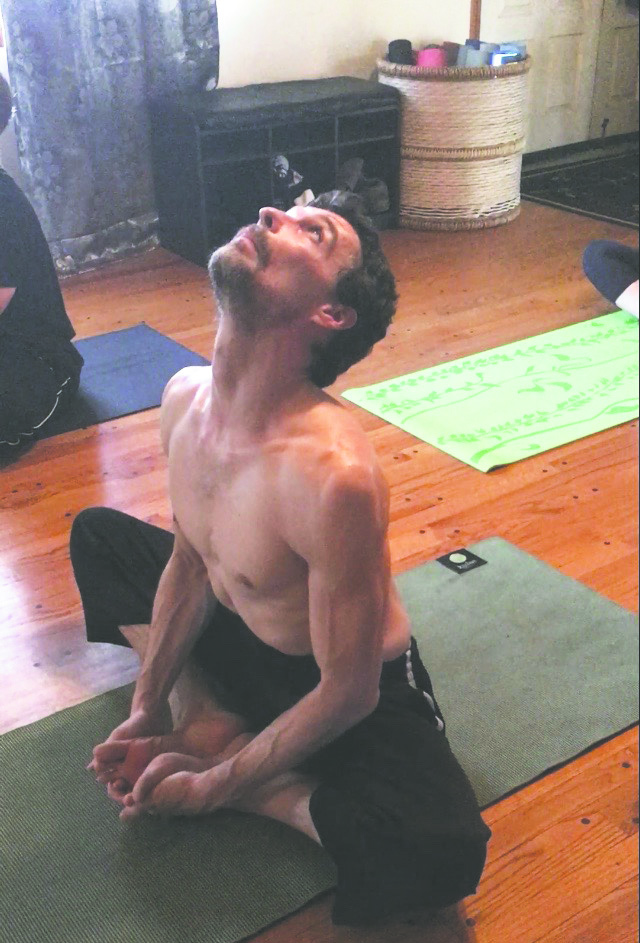Yogi, Instructor, Champion
Glenn Brown shares his wisdom with students through classes offered at IU Southeast.
Glenn Brown practiced yoga with his students instead of walking around them or sitting down like most instructors might.
June 2, 2017
Glenn Brown has competed in the USA Yoga competition for the past 13 years. Each year Brown has competed, he has placed first in Indiana’s state competition, and in 2016, he placed fifth in Nationals.
This year, he placed first in the adult men’s division in super regionals, which was part of the Arnold Supports Festival, and included Indiana and more than 13 other states.
In August, he will compete in USA Yoga nationals in Grand Rapids, Michigan.
“The first 10 years I competed in nationals I didn’t make it past semi-finals,” Brown said.
Brown said the differences between his qualifying routine from previous years, and his routine from the past two years which helped him finally break into the final round, were only including yoga poses he could do smoothly and without strain and not including poses that he isn’t as comfortable executing.
“What will help you win is showing you can do the postures without straining,” Brown said. “Show what you can do, not what you’re striving for. What you wish you could do will happen with time, but it probably won’t happen for the first time on stage in front of a bunch of people.”
Brown instructs yoga and tai chi classes offered at IU Southeast. Outside of IU Southeast, he instructs more than 20 classes a week, splitting time among his studio in New Albany, Bikram Yoga Indiana and Sadhana Yoga Louisville.
Over the years, he has held classes and workshops at studios in Indiana, Kentucky and Illinois. One of his goals as an instructor is to help bridge the gap between different styles of yoga and different yoga communities.
Brown said it is important to realize each yoga style and yoga community has different things to offer which will appeal to different people, and it is important that he can offer those options without undermining any of them.
“Yoga is pretty well known, for the most part, but there is so much misinformation out there that people are turned off before even trying it, or they don’t know that there are varying styles, or they have been told misinformation about every style except for the one at the studio they go to,” Brown said. “As an IUS teacher and studio owner it is my goal to inform, and to give people the knowledge to choose for themselves what their favorite yoga style is, and to teach more about yoga than my opinion, or what my favorite style might be.”
Brown is currently renovating an old grocery store near New Albany High School. This will be his next Lionflow Yoga Studio.
“My studio is in my house right now, where it began over 10 years ago,” Brown said.
His house is 1,300 square feet and the yoga studio is where a living room would be. He can only fit five people in his studio now, but the building being renovated will fit more than 30. Brown practices and teaches yoga every day and is dedicated to the art form and to his personal practice.
Brown said he didn’t always enjoy group yoga classes.
“I had actually been completely turned off to group yoga classes after trying the Vinyasa yoga style. It’s very repetitive, and though it appeals to many, it wasn’t the style for me. Since it was the only style around at that time, I used a book by BKS Iyengar, ‘Light on Yoga’, to develop non-repetitive posture sequences to compliment my private kung-fu and meditation practice,” he said. “I had the misconception at that time, like many still do today, that all yoga classes around were the same style.”
Brown said his opinion was changed when a Bikram Yoga studio opened in New Albany.
“The physicality of the Bikram style and it’s focus on postures I was unfamiliar with was appealing to me. It was the challenge comparable to kung-fu practice that I had been looking for,” he said. “Six months after my first class I went to Bikram Yoga College Teacher Training to become a yoga teacher. I guess the real moral to that story is that there is a style of yoga suited for everyone, but you might have to try more than one style or studio before you find the right fit for you.”

According to Brown, there are many different types of yoga, and most styles available today are derived from Ashtanga Vinyasa, or Bikram Yoga, and sometimes a blend of both.
“The style known as simply ‘Vinyasa’ is probably the most common, and it derived from Ashtanga Vinyasa, which has different levels of class with fixed series. Whereas the Vinyasa style is blended organically by the teacher each time it is taught using a series from Ashtanga Vinyasa, and any other yoga style the teacher may have encountered,” he said. “Some students enjoy more structure, and some prefer a more creative flow, so all the styles have purpose in appealing to our diverse needs.”
After teaching more than 10 Bikram Yoga classes a week for over 10 years, Brown said he became more drawn to teach what he practiced.
“I’ve been developing my personal practice ever since grade school as a way to keep progressing during the off-season from sports, to enhance my performance and to help me chase the records set by my older brothers. I continued my daily personal practice even as I went through my kung-fu and yoga trainings, and it has influenced both,” he said. “After over 10 years of teaching private lessons on the side, in 2010 I finally named my personal practice Lionflow Progressive Yoga & Arts LLC, or Lionflow Yoga, and opened my own studio in my living room.”
Brown said the studio has been in many locations over the past seven years, and that he is excited for the new studio to open.
“I’ll finally have the space and stability I need to turn my vision for Lionflow Yoga Studio into reality,” he said.
Lionflow Yoga is designed to safely strengthen muscles throughout the body, allow students to reap all the benefits of yoga and to challenge them. One of the things that make a Lionflow class unique from other styles of yoga is that the teacher leads the class physically and verbally. In most yoga classes, the teacher doesn’t participate in the class and instead sits or walks around the room.
“In martial arts the teacher practices in front of the class so students can learn from the teacher’s experience: the way they move, the way they breathe, the way they stay calm and focused. All these things are lacking when a teacher just stands in the front of the room,” Brown said.
Brown said most yoga classes available are based on the same sequence and are geared toward beginner and intermediate students. He said he tried to tap into yoga’s foundation when developing his personal practice.
“So as your practice grows, or as your curiosity about the diversity of yoga postures and styles grow, where do you go? Do you spend thousands on a teacher training or spa-like yoga retreat? Where do you go to learn how to tap into your potential and to learn how to build an effective home practice? This is the foundation of a healthy practice, as stated by every yoga and kung-fu master throughout time,” he said. “I felt like I could bring back some of the origins of yoga and offer something that’s a little more intense, but with safe methodology without just falling into the gimmick that’s dominating the time.”
Different level Lionflow classes are offered, ranging from beginner to advanced, and Brown said he strongly believes yoga should be treated as a therapeutic practice as well as a sport and an art form.
“I’ve tried a lot of different types of yoga, and what I found with Lionflow is that it’s different. There wasn’t another style like it. Many Lionflow poses weren’t in other classes even though they’re classical yoga postures,” he said. “You’ll hardly ever see a lotus pose in a yoga class, and that was really odd to me.”
Brown’s personal practice often includes a lotus pose as well as other flexibly-demanding postures. However, he said there was a time when he couldn’t touch his toes. When Brown was a senior in high school, he was kicked out of a kung-fu school for being inflexible.
“I always wanted to do martial arts. I was terrible though. I was very inflexible and uncoordinated and I got kicked out after three months.That motivated me in the most useful way. I have practiced daily ever since,” he said. “Also, I would never treat a student that way myself. If you think about it, it would be ridiculous for a yoga teacher to say you’re too uncoordinated and inflexible to be in my class. I can see dismissing someone from class for being disrespectful, but not for being inflexible, weak, unstable or uninformed. That is the reason you look for a teacher, right?”
Fast forward to the 2016 yoga super regional competition, Brown was able to put both of his feet behind his head and perform a push up.
Donna Stallard, IU Southeast foundations program coordinator and senior lecturer of fine arts, attends Brown’s Lionflow classes as often as she can. She is also certified to teach Lionflow Yoga, and has been training as an instructor for more than three years. She said she likes the challenge.
“I’m in better shape than I was five years ago, better able to concentrate and handle stress. Accept what you can do today and let go of what you can’t change,” Stallard said.
Jonathon Watkins, IU Southeast alumni, also attends Brown’s classes, and is training to become a certified yoga teacher himself.
Brown said it is too easy in the modern era to become a yoga instructor and he doesn’t allow his students to be teachers until after several months of training and physical tests to qualify for each level of class, like a martial art.
“Glenn continues to learn and practice and continues to change classes to what people need, constantly adapting to the needs of his students and I think that is something there’s not enough of,” Watkins said. “It’s amazing.”
Brown said one of the main reasons he teaches classes at IU Southeast is to enrich young people’s lives with yoga, as they often don’t start going to yoga classes until something has gone wrong.
“My hope is to make it easier for students to walk into a studio before the need for therapy has become dire,” Brown said. “The need for preventative care is just as important as the need for therapeutic care. They are actually one in the same.”
Donna Stallard said she agrees.
“It saddens me to see a younger generation of adults letting go of their physical health,” Stallard said. “Everyone could benefit from yoga if they would just allow themselves to try it.”
Brown will teach three yoga classes at IU Southeast during the fall semester, including a three credit class on Mondays and Fridays, a two credit class on Tuesdays and Thursdays and a one credit class on Fridays, all scheduled during the lunch break.


